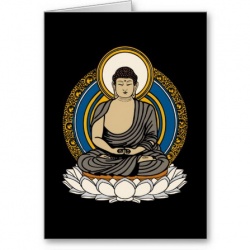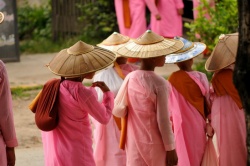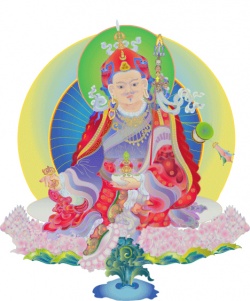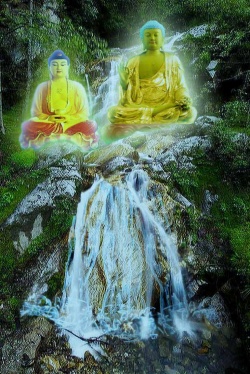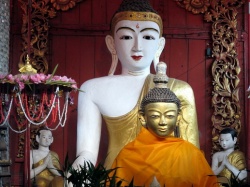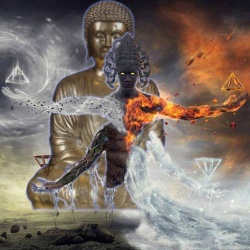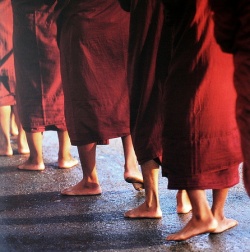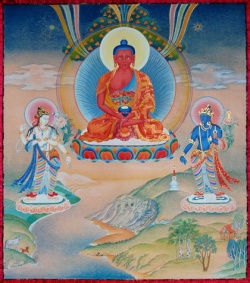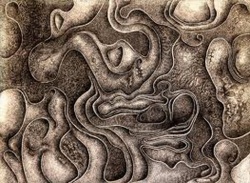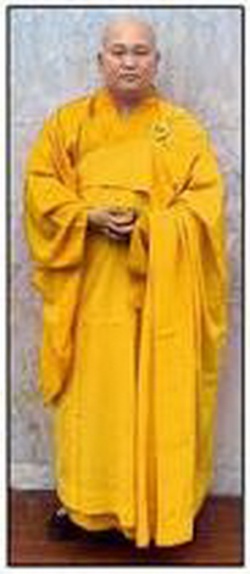Karma
Click here to see other articles relating to word Karma
Karma (Sanskrit, also karma, Pāli: Kamma) means "action" or "doing"; whatever one does, says, or thinks is a karma.
In Buddhism, the term karma is used specifically for those actions which spring from the intention (Sanskrit: cetanā, Pali: cetana) of an unenlightened being. karma (yin-guo):
It refers to the universal law of cause and effect whereby positive actions produce happiness and negative actions produce suffering.
Karma literally means action or the physical, verbal, or mental acts that imprint habitual tendencies in the mind.
Upon meeting with suitable conditions, these habits ripen and become manifest in future events.
All karma created in the present life and previous lives is stored in the alaya-vijnana or the eighth consciousness.
One’s karma will determine where one goes after death if one is an unenlightened or ordinary being.
It is also important to realize that we cannot fully understand the precise workings of karma. Only a Buddha can do this as the Buddha tells us in the Acintita Sutta (Unconjecturable) .
These bring about a fruit (Sanskrit, Pali: phala) or result (S., P.: vipāka; the two are often used together as vipākaphala), either within the present life, or in the context of a future rebirth.
Other Indian religions have different views on karma. Karma is the engine which drives the wheel of the cycle of uncontrolled rebirth (S., P. saṃsāra) for each being.
In the early texts it is not, however, the only causal mechanism influencing the lives of sentient beings.
As one scholar states, "the Buddhist theory of action and result (karmaphala) is fundamental to much of Buddhist doctrine, because it provides a coherent model of the functioning of the world and its beings, which in turn forms the doctrinal basis for the Buddhist explanations of the path of liberation from the world and its result, nirvāṇa."
Karma is the law of cause and effect embedded in Dependent Origination.
Karma, at its most basic, is our action and the result of that action.
The choices we make with our body, speech and mind affect us and others.
The results can sometimes be seen, yet we are often unaware of them.
Under the right conditions, a butterfly flapping its wings in the Pacific can cause a hurricane in the Atlantic.
Equally, our actions have consequences far beyond our imagining - consequences both for ourselves and others.
Karma is a universal law - a truth of existence
Buddhism places specific emphasis on karma because every action, conscious or unconscious, and its result leaves an imprint on the mind - a sort of forward momentum that influences all successive life events.
Being aware of the law of karma helps reinforce our practice.
The teachings and their guidelines support an individual in creating the right conditions for enlightenment.
And along the way, the teachings help modify our actions (karma) in order to promote happiness for ourselves and others.
Etymology & terms in translation
The word karma derives from the verbal root kṛ, which means "do, make, perform, accomplish."
Karma is "the nominative singular form of the neuter word karman, which means 'act, action, performance, deed.'
In grammatical usage, karman refers to the direct object in a sentence, the recipient of the action indicated by the verb."
In the Devanagari script karma is rendered कर्मन्; the Pāli variant is kamma. The terms in translation are as follows: Traditional Chinese: 業, yè, Burmese: ကမၼ, Standard Tibetan: ལས། las (pronounced ley), Thai: กรรม gam, Sinhalese: කර්ම karma, Japanese: 業 or ごう, gou.
Karma in the early sutras
In the early sutras, as found in the Pali Canon and the Agamas preserved in Chinese translation, "there is no single major systematic exposition" on the subject of karma and "an account has to be put together from the dozens of places where karma is mentioned in the texts."
Nevertheless, the Buddha emphasized his doctrine of karma to the extent that he was sometimes referred to as kammavada (the [[holder of the view of [karma]]) or kiriyavada (the promulgator of the consequence of karma).
In the Nibbedhika Sutta (Anguttara Nikaya 6.63) the Buddha said:
Intending, one does kamma by way of body, speech, & intellect."
In the Upajjhatthana Sutta (AN 5.57), the Buddha states:
- "I am the owner of my karma. I inherit my karma. I am born of my karma. I am related to my karma. I live supported by my karma. Whatever karma I create, whether good or evil, that I shall inherit."
Intention and the moral quality of actions
According to Buddhist theory, every time a person acts there is some quality of intention at the base of the mind and it is that quality rather than the outward appearance of the action that determines the effect.
If one appears to be benevolent but acts with greed, anger or hatred, then the fruit of those actions will bear testimony to the fundamental intention that lay behind them and will be a cause for future unhappiness.
The Buddha spoke of wholesome actions (P. kusala-kamma, S. kuśala-karma) that result in happiness, and
unwholesome actions (P. akusala-kamma, S. akuśala-karma) that result in unhappiness.
The Buddha also elaborated that it was impossible for virtuous action to produce unfavorable results, and for nonvirtuous action to produce favorable results.
However, although a good deed may produce merit which ripens into wealth, if that deed was done too casually or the intention behind it was not quite pure, that wealth so obtained sometimes cannot be enjoyed (AN.4.392-393).
There are two classes of determined deeds which always produce good or bad results (fixed results, P. niyato-rasi) respectively, and a class of deeds which may produce either good or bad results (non-fixed results, P. aniyato-rasi) presumably depending on the context, although the Buddha does not elaborate (DN 3.217).
Good karma is described as generating merit (P. puñña, S. puñya), whereas bad karma is described as demerit (apuñña/apuñya or pāpa).
Karmic results
- See also: Anatta.
Anatta and moral responsibility
The Buddha most often spoke of karma as the determining factor of the realm of one's subsequent rebirth--for this reason karma is often explained in tandem with rebirth and cosmology.
The Cūlakammavibhanga Sutta ("The Shorter Exposition of Action," Majjhima Nikaya 3.203) is devoted to describing the various rebirths that various kinds of actions produce; negative actions such as killing lead to rebirths in the lower realms such as hell, and virtuous action such as gracious behavior under duress leads to rebirth in the human or other higher realms.
Further, within human rebirths in particular, virtuous actions produce desirable qualities and good fortune such as physical beauty, influence, and so forth, whereas nonvirtuous actions lead to ugliness, poverty, and other misfortunes.
The Mahākammavibhanga Sutta ("The Greater Exposition of Action," MN.3.208) is a similar exposition, with the additional stipulation that other rebirths may intervene between the time of the virtuous or nonvirtuous actions and the rebirth that they impel.
The Buddha denied one could avoid experiencing the result of a karmic deed once it's been committed (AN 5.292).
In the Anguttara Nikaya, it is stated that karmic results are experienced either in this life (P. diṭṭadhammika) or in a future lives (P. samparāyika).
The former may involve a readily observable connection between action and karmic consequence, as when a thief is captured and tortured by the authorities, but the connection need not necessarily be that obvious and in fact usually is not observable.
Among the results which manifest in future lives, five heinous actions:
(P. ànantarika-kamma) provoke a rebirth in hell immediately subsequent to death,
according to the Vinaya:
matricide,
patricide,
killing an arhat,
intentional shedding of a Buddha's blood, and
causing a schism in the sangha (Vinaya 5.128).
Karmic action & karmic results vs. general causes & general results
The Buddha makes a basic distinction between past karma (P. purānakamma) which has already been incurred, and karma being created in the present (P. navakamma).
Therefore in the present one both creates new karma (P. navakamma) and encounters the result of past karma (P. kammavipāka).
Karma in the early canon is also threefold:
Mental action (S. manaḥkarman),
bodily action (S. kāyakarman) and
vocal action (S. vākkarman).
The Buddha's theory of karmic action and effect did not encompass all causes (S. hetu) and results (S. vipāka).
Any given action may cause all sorts of results, but the karmic results are only that subset of results which impinges upon the doer of the action as a consequence of both the moral quality of the action and the intention behind the action.
In the Abhidharma they are referred to by specific names for the sake of clarity, karmic causes being the "cause of results" (S. vipāka-hetu) and the karmic results being the "resultant fruit" (S. vipāka-phala).
As one scholar outlines, "the consequences envisioned by the law of karma encompass more (as well as less) than the observed natural or physical results which follow upon the performance of an action."
The law of karma also applies "specifically to the moral sphere . . not concerned with the general relation between actions and their consequences, but rather with the moral quality of actions and their consequences, such as the pain and pleasure and good or bad experiences for the doer of the act."
The theory of karma is not deterministic, in part because past karma is not viewed as the only causal mechanism causing the present.
In the case of diseases, for instance, he gives a list of other causes which may result in disease in addition to karma (AN.5.110).
The Buddha's theory of moral behavior was not strictly deterministic; it was conditional.
His description of the workings of karma is not an all-inclusive one, unlike that of the Jains.
The Buddha instead gave answers to various questions to specific people in specific contexts, and it is possible to find several causal explanations of behavior in the early Buddhist texts.
In the Buddhist theory of karma, the karmic effect of a deed is not determined solely by the deed itself, but also by the nature of the person who commits the deed and by the circumstances in which it is committed.
A discourse in the Anguttara Nikaya (AN.1.249) indicates this conditionality:
- A certain person has not properly cultivated his body, behavior, thought and intelligence, is inferior and insignificant and his life is short and miserable; of such a person ... even a trifling evil action done leads him to hell. In the case of a person who has proper culture of the body, behavior, thought and intelligence, who is superior and not insignificant, and who is endowed with long life, the consequences of a similar evil action are to be experienced in this very life, and sometimes may not appear at all.
The Buddha declared that the precise working of how karma comes to fruition was one of the four incomprehensibles (P. acinteyya or acinnteyyāni) for anyone without the insight of a Buddha (AN.2.80).
The Buddha sees the workings of karma with his "superhuman eye."
Contemporary scholar Bruce Matthews asserts that the Cūlakammavibhanga Sutta (M.3.203) indicates that karma provokes "tendencies or conditions rather than consequences as such;" presumably he counts the rebirths resulting from karma described in the sutta as "tendencies or conditions" rather than "consequences," although he does not elaborate the point.
In the Lakkhana Sutta (Digha Nikaya 30), the Buddha explains that his thirty-two special physical characteristics are the fruition of past karma.
Karma & Nirvana
There is a further distinction between worldly, wholesome karma that leads to samsāric happiness (like birth in higher realms), and path-consciousness which leads to enlightenment and nirvana.
Therefore, there is samsāric good karma, which leads to worldly happiness, and there is liberating karma—which is supremely good, as it ends suffering forever.
Once one has attained liberation one does not generate any further karma, and the corresponding states of mind are called in Pali Kiriya.
Nonetheless, the Buddha advocated the practice of wholesome actions: "
Refrain from unwholesome actions/
Perform only wholesome ones/
Purify the mind/
This is the teaching of the Enlightened Ones" (Dhp v.183).
In Buddhism, the term karma refers only to samsāric actions, the workings of which are modeled by the twelve nidanas of dependent origination, not actions committed by Arhats and Buddhas.
Incorrect understandings of karma in the early sutras
In Buddhism, karma is not pre-determinism, fatalism or accidentalism, as all these ideas lead to inaction and destroy motivation and human effort.
These ideas undermine the important concept that a human being can change for the better no matter what his or her past was, and they are designated as "wrong views" in Buddhism. The Buddha identified three:
Pubbekatahetuvada: The belief that all happiness and suffering, including all future happiness and suffering, arise from previous karma, and human beings can exercise no [[volition to affect future results (Past-action determinism).
Issaranimmanahetuvada: The belief that all happiness and suffering are caused by the directives of a Supreme Being (Theistic determinism).
Ahetu-appaccaya-vaada: The belief that all happiness and suffering are random, having no cause (Indeterminism or Accidentalism).
Karma is continually ripening, but it is also continually being generated by present actions, therefore it is possible to exercise free will to shape future karma. P.A. Payutto writes, "the Buddha asserts effort and motivation as the crucial factors in deciding the ethical value of these various teachings on kamma."
Systematization of karma theory in the early schools
As the earliest Buddhist philosophical schools developed with the rise of Abhidharma Buddhism, various interpretations developed regarding more refined points of karma.
All were confronted with a central issue, as one scholar summarizes:
- When [the Buddhist understanding of karma is correlated to the Buddhist doctrine of universal impermanence and No-Self, a serious problem arises as to where this trace is stored and what the trace left is.
The problem is aggravated when the trace remains latent over a long period, perhaps over a period of many existences.
The crucial problem presented to all schools of Buddhist philosophy was where the trace is stored and how it can remain in the ever-changing stream of phenomena which build up the individual and what the nature of this trace is.
As the Buddha had not offered elaboration in the early sutras that addresses this, the various schools proposed various similar yet distinct solutions.
As one scholar writes, "In certain cases it is apparent that concern with karma doctrine or vocabulary explanatory thereof played a distinctly causal role in sectarian evolution.
In other cases it is safer to say that the concern for an intelligible karma vocabulary was one among many complex factors that helped give decisive shape and substance to already distinct or emerging sectarian positions."
One scholar summarizes the various orientations as follows:
- Different sects gave different names to their theoretical candidates for the "carrier of the Karma" . .
The following schools are associated with the following entities: Sammitīya—the avipranāśa or 'indestructible', a dharma of the citta-viprayukta class.
Sarvāstivādin/Vaibhāṣika tradition—prāpti and aprāpti or adhesion and non-adhesion, and the avijñapti·rūpa or form that does not indicate.
Sautrāntika tradition—the bīja or seed,
the ekarasa-skandha or aggregate of unique essence,
the mulāntika-skandha or proximate root aggregate and
the paramārtha-pudgala.
Yogācāra/Vijñānavādin tradition—the ālaya-vijñāna or store house consciousness.
Again, the central question that these entities seem to have been constructed to answer is that of how the karmic force inheres in the psychophysical stream without thereby coloring or pervading each discrete moment of that stream.
What accounts for the "idling" or non-active aspect of defilement when a given thought is of a virtuous or morally indeterminate nature?
The Theravādin commentarial tradition
In the Theravāda Abhidhamma and commentarial traditions, karma is taken up at length.
The Abhidhamma Sangaha of Anuruddhācariya offers a treatment of the topic, with an exhaustive treatment in book five (5.3.7).
Of particular interest is the Kathāvatthu, which "alone of the works of the Pali canon is directly concerned with conflicting views within the Buddhistcommunity. . .
A number of the controverted points discussed in the Kathāvatthu relate either directly or indirectly to the notion of kamma."
This involved debate with the Pudgalavādin school, which postulated the provisional existence of the person (S. pudgala, P. puggala) to account for the ripening of karmic effects over time.
The Kathāvatthu also records debate by the Theravādins with the Andhakas (who may have been Mahāsāṃghikas) regarding whether or not old age and death are the result (vipāka) of karma.
The Theravāda maintained that they are not—not, apparently because there is no causal relation between the two, but because they wished to reserve the term vipāka strictly for mental results-- " subjective phenomena arising through the effects of kamma."
The Visuddhimagga states that "the kamma that is the condition for the fruit does not pass on there (to where the fruit is)."
In the canonical Theravāda view of kamma, "the belief that deeds done or ideas seized at the moment of death are particularly significant."
As scholar Peter Harvey notes, "one curious feature of the Abhidamma view of the perceptual process is that the discernments related to the five physical sense organs are always said to be fruitions of karma."
However, in agreement with scholar L.S. Cousins he agrees that the most "plausible" explanation "is that karma affects discernment by determining which of the many phenomena in a person's sensory range are actually noticed . . in the same room, for example, one person naturally tends to notice certain things which give rise to pleasure, while another tends to notice things which give rise to some displeasure."
As karma is not the only causal agent, the Theravādin commentarial tradition classified causal mechanisms taught in the early texts in five categories, known as Niyama Dhammas:
- Kamma Niyama — Consequences of one's actions
- Utu Niyama — Seasonal changes and climate
- Biija Niyama — Laws of heredity
- Citta Niyama — Will of mind
- Dhamma Niyama — Nature's tendency to produce a perfect type
The Theravāda Abhidhamma also categories karma in other ways:
With regard to function
- Reproductive karma (janaka-kamma) - karma which produces the mental and material aggregates at the moment of conception, conditioning the rebirth-consciousness (patisandhi vinnana).
- Supportive karma (upatthambhaka kamma) - karma ripening in one's lifetime which is of the same favorable or unfavorable quality as the reproductive karma which impelled the rebirth in question.
That is to say, in the case of an animal with an unpleasant life, the karma creating unpleasant conditions would be considered supportive of the reproductive karma which impelled what is considered an unfavorable rebirth.
- Obstructive or counteractive karma (upapiḍaka kamma) - the reverse of the former.
In the example of the animal, an animal with a pleasant life would be said to have obstructive rather than supportive karma in relation to his reproductive karma.
- Destructive karma (upaghātaka kamma) - karma powerful enough to conteract the reproductive karma entirely, by ending the life in question.
With regard to potency
- Weighty kamma (garuka kamma) — that which produces its results in this life or in the next for certain, namely, the five heinous crimes (ānantarika-kamma)
- Proximate kamma (āsanna kamma) — that which one does or remembers immediately before the dying moment
- Habitual kamma (āciṇṇa kamma) — that which one habitually performs and recollects and for which one has a great liking
- Reserve kamma (kaṭattā kamma) — refers to all actions that are done once and soon forgotten
With regard to temporal precedence
- Immediately effective kamma - (diţţhadhammavedaniya kamma) - in the present lifetime
- Subsequently effective kamma - (upapajjavedaniya kamma) - in the immediately following lifetime
- Indefinitely effective kamma - (aṗarāpariyavedaniya kamma) - in lifetimes two or more in the future
- Defunct kamma (ahosi kamma) - (kamma whose effects have ripened already
With regard to the realm-setting of the effect
- Unwholesome (akusala) kamma pertaining to the desire realm (kamavacara)
- Wholesome (kusala) kamma pertaining to the desire realm (kamavacara)
- Wholesome kamma pertaining to the form realm (rupavacara)
- Wholesome kamma pertaining to the formless realm (arupavacara)
The Milindapañha and Petavatthu
The Milindapañha, a paracanonical Theravāda text, offers some interpretations of karma theory at variance with the orthodox position.
In particular, Nāgasena allows for the possibility of the transfer of merit to humans and one of the four classes of petas, perhaps in deference to folk belief (see below, The transfer or dedication of merit).
Nāgasena makes it clear that demerit cannot be transferred.
One scholar asserts that the sharing of merit "can be linked to the Vedic śrāddha, for it was Buddhist practice not to upset existing traditions when well-established custom was not antithetic to Buddhist teaching."
The Petavatthu, which is fully canonical, endorses the transfer of merit even more widely, including the possibility of sharing merit with all petas.
The Vaibhāṣika-Sarvāstivādin school and the Abhidharma-kośa
The Vaibhāśika-Sarvāstivāda, which had by far the most "comprehensive edifice of doctrinal systematics" of the nikaya schools, was widely influential in India and beyond--"the understanding of karma in the Sarvāstivāda in turn became normative not only for Buddhism in India but also for it in other countries."
The Abhidharmahṛdaya by Dharmaśrī was the first systematic exposition of Vaibhāśika-Sarvāstivāda doctrine, and the third chapter, the Karma-varga, deals with the concept of karma systematically.
Another important exposition, the Mahāvibhāṣa, gives three definitions of karma:
For the first usage, karma is supplanted in the text by the synonyms kriya or karitra, both of which mean "activity."
The third usage, karma as that which links certain actions with certain effects, is the primary concern of the exposition.
The 4th century philosopher Vasubandhu compiled the Abhidharma-kośa, an extensive compendium which elaborated the positions of the Vaibhāṣika-Sarvāstivādin school on a wide range of issues raised by the early sutras.
Chapter four the Kośa is devoted to a study of karma, and chapters two and five contain formulation as to the mechanism of fruition and retribution.
This became the main source of understanding of the perspective of early Buddhism for later Mahāyāna philosophers.
The notion of avijñapti—an unseen latent power that is nonetheless momentary—is significant to the Vaibhāṣika-Sarvāstivādin accounting of how karmic action precipitates karmic results.
Vasubhandu elaborates on the causes (S. hetu, Tib. rgyu) and conditions (S. pratyaya, Tib. rkyen, Pāli: paccaya) involved in the production of results (S. vipākaphalam, Tib. rnam-smin-gyi 'bras-bu), karma being one source of causes and results, the "ripening cause" and "ripened result."}
Generally speaking, the conditions can be thought of as auxiliary causes.
Vasubhandhu draws from the earlier Sarvāstivādin Abhidharma treatises to establish an elaborate Buddhist etiology with the following primary components:
Six Causes
- Acting causes (S. kāraṇahetu, T. byed-rgyu) – all phenomena, other than the result itself, which do not impede the production of the result.
This includes
- Simultaneously arising causes (S. sahabhuhetu, T. lhan-cig 'byung-ba'i rgyu) – causes that arise simultaneously with their results. This would include, for instance, characteristics together with whatever it is that possesses the characteristics.
- Congruent causes ( Skt. saṃmprayuktahetu, T. mtshungs-ldan-gyi rgyu) – a subcategory of simultaneously arising causes, it includes causes share the same focal object, mental aspect, cognitive sensor, time, and slant with their causes—primarily referring to the primary consciousness and its congruent mental factors.
- Equal status cause (S. sabhagahetu, T. skal-mnyam-gyi rgyu ) – causes for which the results are later moments in the same category of phenomena. For example, one moment of patience can be considered the cause of the next moment of patience.
- Driving causes (S. sarvatragohetu, T. kun groi rgyu) – disturbing emotions and attitudes that generate other subsequent disturbing emotions and attitudes in the same plane of existence, though the two need not be of the same ethical status.
- Ripening cause (Skt. vipākahetu, T. rnam-smin-gyi rgyu) - the karmic cause or efficacy.
- Causal conditions (S. hetupratyaya, T. rgyu-rkyen) - corresponds to five of the six causes, excepting the kāraṇahetu, which corresponds to the three conditions below
- Immediately preceding conditions (S. samanantarapratyaya, T. dema thag rkyen) - a consciousness which precedes a sense or mental consciousness without any intervening consciousness and which produces the subsequent consciousness into an experience-ready entity
- Focal condition (S. alambanapratyaya, T. dmigs-rkyen) - or "object condition" - an object which directly generates the consciousness apprehending it into having its aspect, e.g. the object blue causes an eye consciousness to be generated into having the aspect of blue
- Dominating condition (S. adhipatipratyaya, T. bdag-rkyen) -
Five Types of Results:
- Ripened results (S. vipakaphalam, T. rnam smin gyi 'bras-bu) - karmic results.
- Results that correspond to their cause (S. niṣyandaphalam, T. rgyu-mthun gyi 'bras-bu) - causally concordant effects
- Dominating results (S. adhipatiphalam, bdag poi bras bu) - the result of predominance. All conditioned dharmas are the adhipatiphala of other conditioned dharmas.
- Man-made results (S. puruṣakāraphalam, T. skyes bu byed-pa'i 'bras-bu) - a result due to the activity of another dharma
- Results that are states of being parted (S. visamyogaphalam, T. bral 'bras) - not actually a result at all, but refers to the cessation that arises from insight.
The Dārṣṭāntika-Sautrāntika view
The Dārṣṭāntika-Sautrāntika school pioneered the idea of karmic seeds (S. bija) and "the special modification of the psycho-physical series" (S. saṃtatipaṇāmaviśeṣa) to explain the workings of karma.
The Pudgalavāda view
Although the views of the Pudgalavāda were considered somewhat heretical by other Indian Buddhist schools, they were in all likelihood the most populous non-Mahayanist sect in India, estimated at between a quarter of all non-Mahayana monks up to double the number of the next largest sect. According to scholar Joseph Walser,
- The Pudgalavādins argued that karma was a composite entity consisting of several temporal components and one atemporal one. Following the Buddhists sūtras, they claimed that mental saṃskāras (mental formations corresponding to karma) were of the nature of volition. Vocal and bodily karma, however, consisted only of the motion (gati) that could be observed. The motion itself is conditioned and therefore impermanent. The Pudgalavādins were, however, aware that the Buddha also taught the persistence of karma. In this the Pudgalavādins appealed to a text that was also considered authoritative by the Sarvāstivādins:
“Karma does not perish, even after hundreds of millions of cosmic eras. When the complex [of conditions and (favorable) times come together, they ripen for their author.” One particular subsect of Pudgalavādins—-the Saṃitīyas—-took the imperishability of karma to be one thing and the causes and conditions of karma to be another. They posited the existence of an entity called, appropriately enough, the “indestructible” (avipraṇāśa), separate from the karma itself. This “indestructible” acts like a blank sheet of paper on which the actions (karma) are written.
- . . .The Pudgalavādin Abhidharma puts a definite spin on the sūtra tradition in their claims that karma persisted because of avipraṇāśa (in the case of the Saṃitīyas) and in claiming that pudgala was neither saṃsṛkta nor asaṃsṛkta (in the case of all Pudgalavādins). Yet the payoff for these maneuvers was sufficient to warrant such a move.. . in positing an avipraṇāśa, the Saṃitīyas could appeal to the words of the Buddha saying that karma was indestructible. By claiming that the pudgala was existent, they could meaningfully talk about the owner of karma while at the same time be able to explain how this owner could move from saṃsāra to nirvaṇā."
Karma theory in Mahāyāna schools
Transfer or dedication of merit
Initially in the western study of Buddhism, some scholars believed that the transfer of merit was at first a uniquely Mahāyāna practice and that it was developed only at a late period, perceiving that it was somewhat discordant with early Buddhist understandings of karma theory. Scholar Heinz Bechert dates the Buddhist doctrine of transfer of merit (Sanskrit: puṇyapariṇāmanā) in its fully developed form to the period between the 5th and 7th centuries CE. However, Sree Padma and Anthony Barber note that merit transfer was well established and a very integral part of Buddhist practice in the Andhra region of southern India. In addition, inscriptions at numerous sites across South Asia provide definitive evidence that the transfer of merit was widely practiced in the first few centuries CE.
As scholar D. Seyfort Ruegg notes,
- An idea that has posed a number of thorny questions and conceptual difficulties for Buddhist thought and the history of the Mahāyāna is that often referred to as 'transfer of merit' (puṇyapariṇāmanā). The process of pariṇāmanā (Tib. yons su bsno ba) in fact constitutes a most important feature in Mahāyāna, where it denotes what might perhaps best be termed the dedication of good (puṇya, śubha, kuśala(mula); Tib. bsod nams, dge ba'i rtsa ba) by an exercitant in view of the attainment by another karmically related person (such as a deceased parent or teacher) of a higher end. Yet such dedication appears, prima facie, to run counter to the karmic principle of the fruition or retribution of deeds (karmavipāka).
Generally accepted in Buddhism, both Mahāyānist and non-Mahāyānist, this principle stipulates that a karmic fruit or result (karmaphala) is 'reaped', i.e. experienced, solely by the person - or more precisely by the conscious series (saṃtāna) - that has sown the seed of future karmic fruition when deliberately (cetayitva) accomplishing an action (karman).
- The related idea of acquisition/possession (of 'merit', Pali patti, Skt. prāpti), of assenting to and rejoicing in it (pattānumodanā), and even of its gift (pattidāna) are known to sections of the Theravāda tradition; and this concept - absent in the oldest canonical texts in Pali, but found in later Pali tradition (Petavatthu, Buddhāpadāna) - has been explained by some writers as being due to Mahāyānist influence, and by reference to Nalinaksha Dutt's category of 'semi-Mahāyāna.'
Scholar Tommi Lehtonen notes that (fellow scholar) "Wolfgang Schumann says that that "the Mahāyāna teaching of the transfer of merit `breaks the strict causality of the Hinayānic law of karman (P. kamma) according to which everybody wanting better rebirth can reach it solely by his own efforts’ . Yet, Schumann claims that on this point Mahāyāna and Hinayāna differ only in the texts, for the religious practice in South East Asia acknowledges the transference of karmic merit (P. pattidāna) in Theravāda as well."
Karma theory in Indian Yogācāra philosophy
In the Yogācāra philosophical tradition, one of the two principal Mahāyāna schools, the principle of karma was extended considerably. In the Yogācāra formulation, all experience without exception is said to result from the ripening of karma. Karmic seeds (S. bija) are said to be stored in the "storehouse consciousness" (S. ālayavijñāna) until such time as they ripen into experience. The term vāsāna ("perfuming") is also used, and Yogācārins debated whether vāsāna and bija were essentially the same, the seeds were the effect of the perfuming, or whether the perfuming simply affected the seeds. The seemingly external world is merely a "by-product" (adhipati-phala) of karma. The conditioning of the mind resulting from karma is called saṃskāra.
The Treatise on Action (Karmasiddhiprakaraṇa), also by Vasubandhu, treats the subject of karma in detail from the Yogācāra perspective. According to scholar Dan Lusthaus, "Vasubandhu's Viṃśatikā (Twenty Verses) repeatedly emphasizes in a variety of ways that karma is intersubjective and that the course of each and every stream of consciousness (vijñāna-santāna, i.e., the changing individual) is profoundly influenced by its relations with other consciousness streams."
As one scholar argues, whereas in earlier systems it "was not clear how a series of completely mental events (the deed and its traces) could give rise to non-mental, material effects," with the (purported) idealism of the Yogācāra system this is not an issue.
The Mahayana Diamond Sutra (Vajracchedika-sutra) also is perhaps suggestive of the Mahāyāna tendency to attribute all happiness and suffering to karmic ripening:
- The happiness and suffering of all beings,
- are due to karma, the Sage taught;
- Karma arises from diverse acts,
- which in turn create the diverse classes of beings
In Mahāyāna traditions, karma is not the sole basis of rebirth. The rebirths of bodhisattvas after the seventh stage (S. bhūmi) are said to be consciously directed for the benefit of others still trapped in saṃsāra. Thus, theirs are not uncontrolled rebirths.
Karma theory in Indo-Tibetan Mādhyamaka philosophy
Nāgārjuna articulated the difficulty in forming a karma theory in his most prominent work, the Mūlamadhyamakakārikā (Fundamental Verses on the Middle Way): If (the act) lasted till the time of ripening, (the act) would be eternal. If (the act) were terminated, how could the terminated produce a fruit? The Mūlamadhyamakavṛtty-Akutobhayā, also generally attributed to Nāgārjuna, concludes that it is impossible both for the act to persist somehow and also for it to perish immediately and still have efficacy at a later time.
Mādhyamaka schools deriving from Nāgārjuna subsequently took one of two approaches to the problem. The Svātantrika-Mādhyamaka generally borrowed the philosophy of karma from the Yogācāra. The Prāsaṅgika-Mādhyamaka refuted every concept of a support for ongoing karmic efficacy, while nevertheless postulating that a potential (T. nus pa) is formed which substantiates whenever the situation is ripe. Candrakīrti, the definitive exponent of Prāsaṅgika, argued that because this potential is not a thing, that is, not an "inherently real phenomenon," it does not need to be supported in any way. One scholar argues that "in India, the Prāsaṅgikas' various viewpoints of karma were never organized into a coherent and convincing system."
In Tibet
Tsongkhapa, the founder of the Gelug school of Tibetan Buddhism, argued that the Prāsaṅgika position allowed for the postulation of something called an "act's cessation" (las zhig pal) which persists and is in fact a substance (rdzas or dngos po, S. vastu), and which explains the connection between cause and result. Gorampa, an important philosopher of the Sakya school of Tibetan Buddhism, accused Tsongkhapa of a doctrinal innovation not legitimately grounded in Candrakīrti's work, and one which amounted to little more than a (non-Buddhist) Vaiśeṣika concept. Gelugpa scholars offered defenses of the idea.
Karma theory in East Asian Buddhism
Zen and karma
Dōgen Kigen argued in his Shobogenzo that karmic latencies are emphatically not empty, going so far as to claim that belief in the emptiness of karma should be characterized as "non-Buddhist," although he also states that the “law of karman has no concrete existence.”
Tendai
The Japanese Tendai/Pure Land teacher Genshin taught that Amida Buddha has the power to destroy the karma that would otherwise bind one in saṃsāra.
Karma in Vajrayana
In the Vajrayana tradition, it is believed that the effects of negative past karma can be "purified" through such practices as meditation on Vajrasattva. The performer of the action, after having purified the karma, does not experience the negative results he or she otherwise would have.
The Karma Buddha family in Indo-Tibetan Buddhism
The dhyani Buddhas, also called Five Wisdom Buddhas, are built on five Buddha families (Kullas, Buddhakula). One of them is named the Karma family presided by Buddha Amoghasiddhi. The symbol/emblem of that family is the double vajra.
Modern interpretations and controversies
Karma theory & social justice
Since the exposure of the West to Buddhism, some western commentators and Buddhists have taken exception to aspects of karma theory, and have proposed revisions of various kinds. These proposals fall under the rubric of Buddhist modernism. As one scholar writes, "Some modern Buddhist thinkers appear largely to have abandoned traditional views of karma and rebirth in light of the contemporary transformation of the conception of interdependence," preferring instead to align karma purely with contemporary ideas of causality. One scholar writes, "it is perhaps possible to say that both Buddhism and Buddhist ethics may be better off without the karmic-rebirth factor to deal with." Often these critical writers have backgrounds in Zen and/or Engaged Buddhism.
The "primary critique" of the Buddhist doctrine of karma is that some feel "karma may be socially and politically disempowering in its cultural effect, that without intending to do this, karma may in fact support social passivity or acquiescence in the face of oppression of various kinds." Dale S. Wright, a scholar specializing in Zen Buddhism, has proposed that the doctrine be reformulated for modern people, "separated from elements of supernatural thinking," so that karma is asserted to condition only personal qualities and dispositions rather than rebirth and external occurrences.
One scholar and Zen practitioner, David Loy, echoes these remarks. He writes, "what are we going to do about karma? There's no point in pretending that karma hasn't become a problem for contemporary Buddhism . .Buddhism can fit quite nicely into modern ways of understanding. But not traditional views of karma." Loy argues that the traditional view of karma is "fundamentalism" which Buddhism must "outgrow."
Loy argues that the idea of accumulating merit too easily becomes "spirtitual materialism," a view echoed by other Buddhist modernists, and further that
- Karma has been used to rationalize racism, caste, economic oppression, birth handicaps and everything else. Taken literally, karma justifies the authority of political elites, who therefore must deserve their wealth and power, and the subordination of those who have neither. It provides the perfect theodicy: if there is an infallible cause-and-effect relationship between one's actions and one's fate, there is no need to work toward social justice, because it's already built into the moral fabric of the universe. In fact, if there is no undeserved suffering, there is really no evil that we need to struggle against. It will all balance out in the end.
While some strands of later Buddhist thought did attribute all experience to past karma, the early texts explicitly did not, and in particular state that caste is not determined by karma.
Loy goes on to argue that the view that suffering such as that undergone by Holocaust victims could be attributed in part to the karmic ripenings of those victims is "fundamentalism, which blames the victims and rationalizes their horrific fate," and that this is "something no longer to be tolerated quietly. It is time for modern Buddhists and modern Buddhism to outgrow it" by revising or discarding the teachings on karma. Other scholars have argued, however, that the teachings on karma do not encourage judgment and blame, given that the victims were not the same people who committed the acts, but rather were just part of the same mindstream-continuum with the past actors, and that the teachings on karma instead provide "a thoroughly satisfying explanation for suffering and loss" in which believers take comfort.
The question of the Holocaust also occurs in the Jew in the Lotus: A Poet's Re-Discovery of Jewish Identity in Buddhist India, which describes a group of Jewish religious leaders who meet with the Dalai Lama. They ask one of the Dalai Lama's party, a Buddhist scholar named Geshe Sonam Rinchen, if the Holocaust would be attributed to past karma in the traditional Buddhist view, and he affirms that it would. The author is "shocked and a little outraged," because, like Loy, he felt it "sounded like blaming the victim."
Many modern Buddhists such as Thich Nhat Hanh prefer to suggest the "dispersion of karmic responsibility into the social system," such that "moral responsibility is decentered from the solitary individual and spread throughout the entire social system," reflecting the left-wing politics of Engaged Buddhism.
Is there collective or national karma?
Other modern Buddhists have sought to formulate theories of group, collective and national karma which are not found in traditional Buddhist thinking. The earliest recorded instance of this occurred in 1925, when a member of the Maha Bodhi named Sheo Narain published an article entitled "Karmic Law" in which he invited Buddhist scholars to explore the question of whether an individual is "responsible not only for his individual actions in his past life but also for past communal deeds."
As one scholar writes, "a systematic concept of group karma was in no sense operative in early Theravada" or other schools based on the early sutras. "Instead," he writes, "the repeated emphasis in the canonical discussions of karma is on the individual as heir to his own deeds. It is only in this century, then, that one finds a conscious effort to split with this tradition."
Buddhism does not deny that the actions taken by one generation of the citizens of a given country will have effects on later generations, for example. However, as noted above, all effects of actions are not karmic effects. Karmic effects impinge only on the mindstreams of those sentient beings who perform the actions. As Nyanatiloka Mahathera writes, individuals
- should be responsible for the deeds formerly done by this so-called 'same' people. In reality, however, this present people may not consist at all of the karmic heirs of the same individuals who did these bad deeds. According to Buddhism it is of course quite true that anybody who suffers bodily, suffers for his past or present bad deeds. Thus also each of those individuals born within that suffering nation, must, if actually suffering bodily, have done evil somewhere, here or in one of the innumerable spheres of existence; but he may not have had anything to do with the bad deeds of the so-called nation. We might say that through his evil Karma he was attracted to the miserable condition befitting to him. In short, the term Karma applies, in each instance, only to wholesome and unwholesome volitional activity of the single individual.
Thus, in the traditional view the effects of the actions of other beings—such as the leader of one's country, or prior generations of its citizens—might well serve as causes of suffering for an individual on one level, but not they would not be the karmic causes of the suffering of that individual—those causes would function in congruence with the karmic causes. There is, therefore, no "national karma" in traditional Buddhism. One "scholar of engaged Buddhism" wrote an article asserting that the "collective karma" of the United States deriving from the Abu Ghraib torture and prisoner abuse would potentially "play out for generations," a view that is not supported by traditional Buddhist views of karma. The effects may well be felt by Americans for generations, but they would not constitute "collective karma."
"Collective karma" could be spoken of only in certain limited senses in the canonical tradition. In Vasubandu's Karmasiddhiprakarana, among other places, it is asserted that a group of individuals who collaborate and share the same intention for a planned action will all incur karmic merit or demerit based on that action, regardless of which individual actually carries out the action. The fruition of their merit or demerit, however, will not necessarily be experienced by each of the individuals together, and/or at the same time.
Likewise, "family karma" is possible only when it refers to karmic dispositions which are similar in each individual family member. One scholar points out, "statements concerning group karma . . .are subject to conceptual confusion. It is important to distinguish group karma from what might be termed conjunctive karma, that is, the karmic residues which we experience as a result of the actions of everyone or everything operating casually in the situation, but which are justified by our own accumulated karma. . . the actions of many persons . . .mediate our karma to us. But this is not group karma, for the effect which we experience is justified by our own particular acts or pool of karma, and not by the karmic acts or pool of the group, even though it is mediated by the actions of others."
Is karma just "social conditioning?"
Buddhist modernists also often prefer to equate karma with social conditioning, in contradistinction with, as one scholar puts it, "early texts [which] give us little reason to interpret 'conditioning' as the infusion into the psyche of external social norms, or of awakening as simply transcending all psychological conditioning and social roles. Karmic conditioning drifts semantically toward 'cultural conditioning' under the influence of western discourses that elevate the individual over the social, cultural, and institutional. The traditional import of the karmic conditioning process, however, is primarily ethical and soteriological—actions condition circumstances in this and future lives."
Essentially, this understanding limits the scope of the traditional understanding of karmic effects so that it encompasses only saṃskāras—habits, dispositions and tendencies—and not external effects, while at the same time expanding the scope to include social conditioning that does not particularly involve volitional action.
Source
When people are happy and contented, they tend to take life for granted. It is when they suffer, when they find life difficulty, that they begin to search for a reason and a way out of their difficulty. They may ask why some are born in poverty and suffering, while others are born in fortunate circumstances. Some people believe that it is due to fate, chance, or an invisible power beyond their control. They feel that they are unable to live the life they desire so as to experience happiness always. Consequently , they become confused and desperate. However, the Buddha was able to explain why people differ in their circumstances and why some are more fortunate in life than others. The Buddha taught that one’s present condition, whether of happiness or suffering, is the result of the accumulated force of all past actions or karma.
Definition of Karma
Karma is intentional action, that is, a deed done deliberately through body, speech or mind. Karma means good and bad volition (kusala Akusala Centana). Every volitional action (except that of a Buddha or of an Arahant) is called Karma. The Buddhas and Arahants do not accumulate fresh Karma as they have destroy all their passions.
In other words, Karma is the law of moral causation. It is action and reaction in the ethical realm. It is natural law that every action produces a certain effect. So if one performs wholesome actions such as donating money to charitable organisations, one will experience happiness. On the other hand, if one perform unwholesome actions, such ass killing a living being, one will experience suffering. This is the law of cause and effect at work. In this way, the effect of one’s past karma determine the nature of one’s present situation in life.
The Buddha said,
"According to the seed that is sown,
So is the fruit you reap
The door of good will gather good result
The door of evil reaps evil result.
If you plant a good seed well,
Then you will enjoyed the good fruits."
Karma is a law itself. But it does not follow that there should be a law-giver. The law of Karma, too, demands no law giver. It operates in its own field without the intervention of an external, independent agency.
Principle of Cause and Effect
General Principle
As one sows, so shall one reap. Every effect arises from a cause. Under certain conditions, a cause will come to an effect. This is a universal principle, on which Buddhist morality is based.
Here's a verse.
If you want to know the causes in your past life,
The way you live at present is the effect of your past life.
If you want to know what your future life will be,
What you do at present is the cause of your future life.
In the world, some beings are fortunate while others are less fortunate. Some are happy while others are less happy. Why?
The Buddha has specifically stated that Karma explains the differences between living beings. It is also Karma that explains the circumstances that living beings find themselves in.
Law of Karma
Karma is not fate nor predestination.
Literally, Karma means "action", "to do".
Action itself is considered neither good nor bad, but only the intention and thought make it so. Thus, Karma is an intentional, conscious, deliberate and wilful action. Karma is volition.
Every action must have a reaction, i.e. an effect. The truth applies both to physical world (expressed by the great physicist Newton) and to the moral world.
Law of Karma is an important application of the Principle of Cause and Effect in morality.
The denial of the Law will destroy all moral responsibility.
There are two kinds of Karma:
Good Karma (Kushala)
It means intelligent, or skillful. It refers to those intentional actions, which are beneficial to oneself and others, springing out from kindness, compassion, renunciation and wisdom.
Bad Karma (Akushala)
It means not intelligent, not skillful. It refers to those intentional action springing out from greed, hatred and illusion.
For unintentional actions, such as walking, sleeping, breathing, they have no moral consequences, thus constitute neutral Karma or ineffective Karma.
Rebirth in Six Paths
By practicing the Ten Good Deeds and Ten Meritorious Deeds, the fully ripened fruit of these wholesome actions consists of rebirth in the higher realms of happiness, i.e. Man, Asura and Deva.
Conversely, the full ripened fruit of the unwholesome action consists of rebirth in the lower realms of suffering, i.e. Hell, Hungry ghosts and Animals.
The effect of Karma may be evident either in short term or in the long term. Karma can either manifest its effects in this very life or in the next life or only after several lives.
Cause and Condition
Every cause has its effect. However, there must be conditions that are ripe for the effect. Karma, be it good or bad, can be affected by the conditions under which the actions are performed.
The conditions that determine the strength or weight of Karma apply to the subject and object of the action. Moreover, there are five conditions that modify the strength of Karma:
- 1. persistent, repeated action
- 2. action done with great intention and determination
- 3. action done without regret
- 4. action done towards those who possess extraordinary qualities
- 5. action done towards those who have benefited one in the past.
Though Buddhism stresses on Karma, it rejects fate. One should take good actions all the time, and let all good conditions arise so that:
- 1. evil retribution has little chance to come to an effect
- 2. good retribution becomes more and more significant in enhancing our lives in happiness and wellness.



